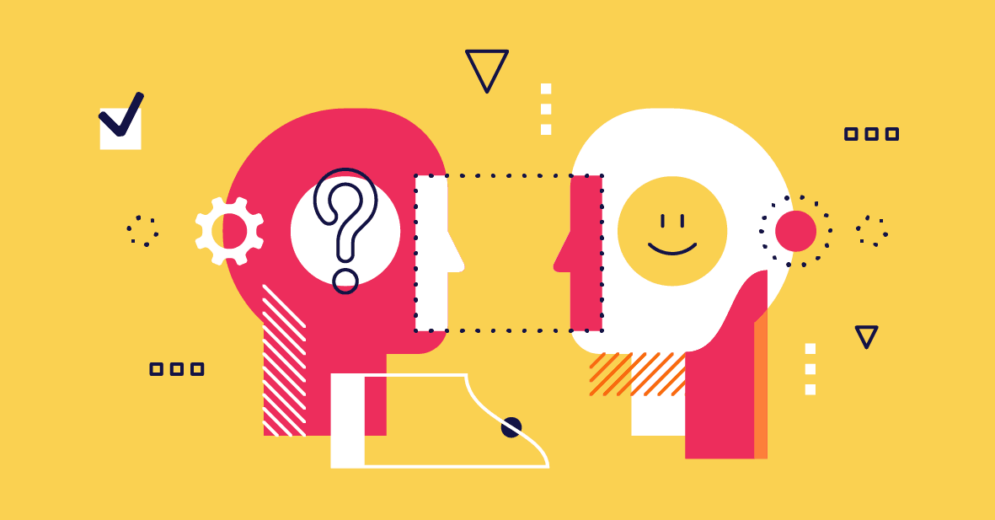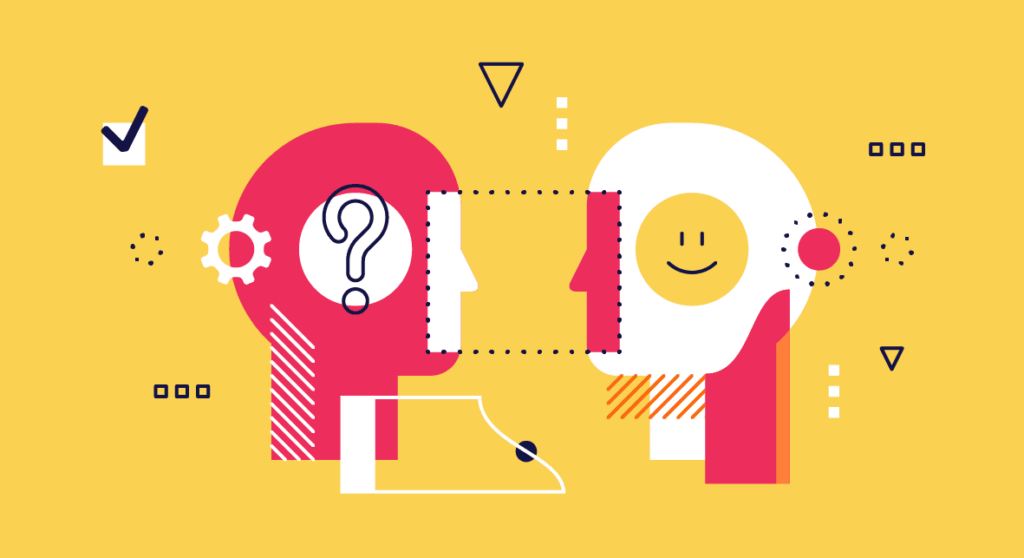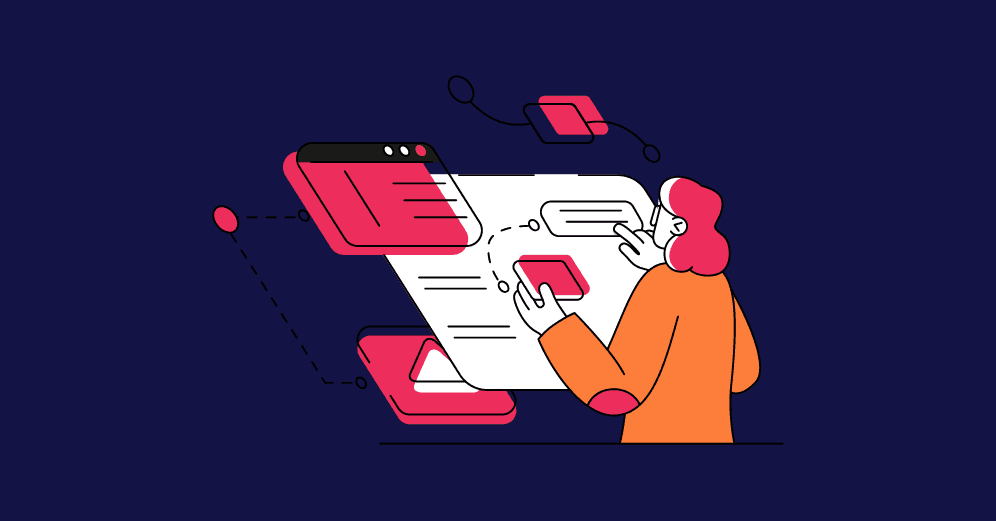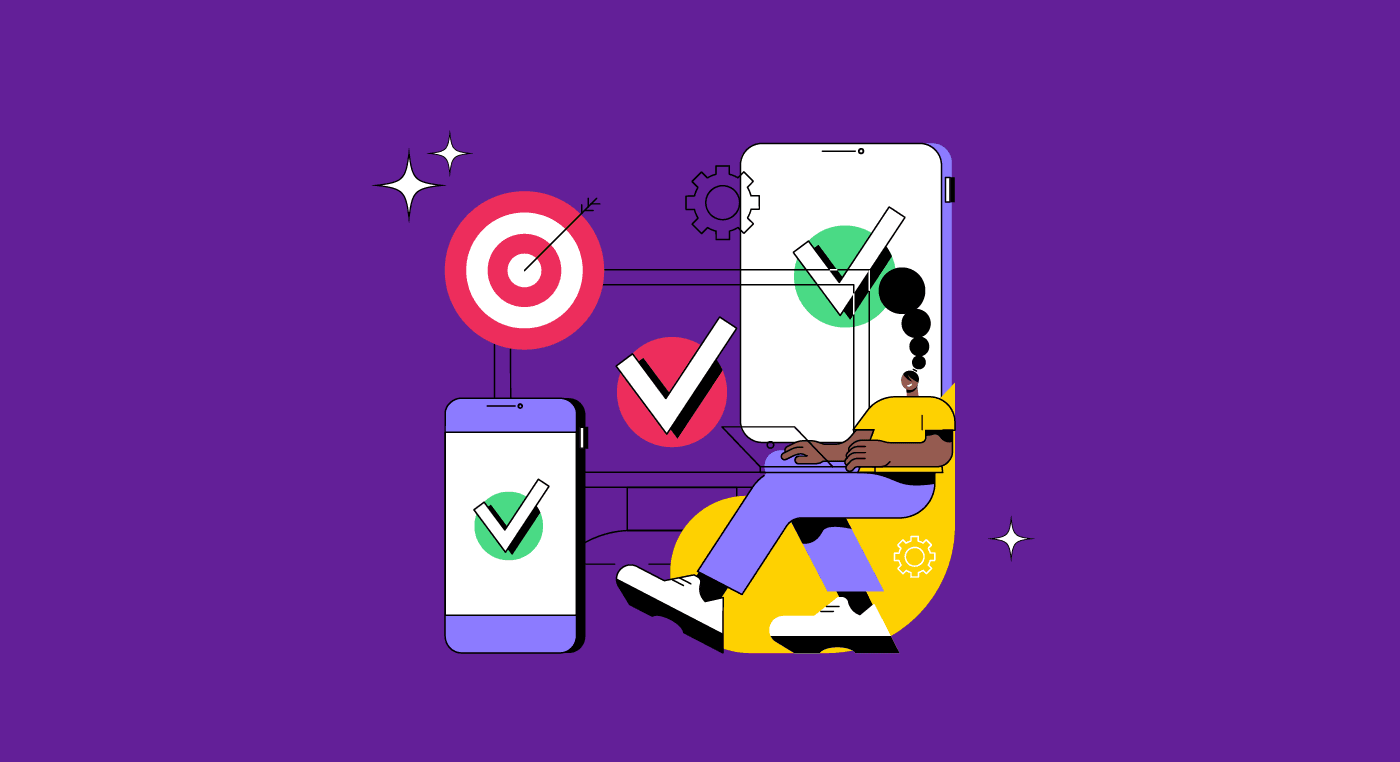If you are looking for an innovative and disruptive solution, Design Thinking may be just what you need.
Design Thinking is an approach that leads the way to innovation because it helps us empathize with the user before trying to solve their problems.
Another important aspect is that the process questions the pre-defined problem rather than quickly jumping into a solution, which allows for the exploration of various hypotheses before arriving at a prototype. And it is precisely in this exploration and divergence that the best ideas are born.
Understand what Design Thinking is, learn about the main models, and how to apply this methodology to ensure better deliverables and products. Enjoy the reading!
Reading tip: Emotional Design: Adding Value To Your Products
What is Design Thinking?
Before delving into the concept of Design Thinking, I invite you to reflect on the meaning of iteration.
An iterative process means revising and ‘calibrating’ a project continuously. As such, the progress of an iterative delivery happens through constant refinement of a product or project.
We can say that Design Thinking is a collection of processes and tools applied iteratively in order to address problems through innovation.
So, how is this done? By understanding the user in-depth, recognizing patterns, building empathy, and generating insights to uncover or reframe a problem, to explore hypotheses to solve it.
Design Thinking also promotes the use of creative tools by everyone, not just designers or technology companies.
Thus, the great thing about this approach is that besides being inclusive, it can be applied in any business or situation, regardless of your area or background.
Remember: Design Thinking is an iterative and exploratory process. The steps can occur simultaneously and should be seen more like activities that overlap than ordered steps.
Design can help to improve our lives in the present. Design thinking can help us chart a path into the future. — Tim Brown
Great minds behind Design Thinking

Although the application of Design Thinking as a methodology or mindset is relatively new, the scientific method has been discussed for several decades by scientists and researchers.
Richard Buchanan was one of the first to address the term Design Thinking when he published the famous article Wicked Problems in Design Thinking which presents the characteristics of Complex Problems and how they interact with design thinking.
The cool thing was that Buchanan referred to Design in a broad way that reached out to everyone, not just professionals in academia. By doing so, he extended the topic to all people who somehow use design in their routines to solve complex problems.
What many people call “impossible” may actually only be a limitation of imagination that can be overcome by better design thinking. — Richard Buchanan
Cognitive scientist and Nobel Prize winner Herbert Simon was already talking about rapid prototyping and tests by observation in the 1970s. You will see throughout this article that these topics are central themes of Design Thinking.
Herbert’s work focused on the development of Artificial Intelligence and the possibility of synthesizing human ways of thinking.
Another major contributor to what we know today as Design Thinking was Robert H. McKim, who focused his studies on the impact that Visual Thinking has on our understanding of things and our ability to solve problems.
McKim’s book reveals various aspects of Visual Thinking and Design methods for solving problems in a more holistic way. The ideas laid out in the book underpin the methodology of Design Thinking.
IDEO

The Design Thinking process gained notoriety with David Kelley, professor at Stanford University, and Tim Brown, author of the book Change by Design. Together they founded the innovation consulting firm IDEO, which was the main disseminator of the method.
Brown was also responsible for presenting the Design Thinking process in the Harvard Business Review in 2008, which led to worldwide repercussions and put this approach under the spotlight of the tech industry.
According to IDEO, the Design Thinking process must bring together what is desirable from the customer’s point of view with what is technologically possible and economically viable from the business’ perspective. It is at the intersection of these three factors where we find solutions and innovation.
How can you benefit from Design Thinking
The central focus of Design Thinking is a genuine interest in understanding the user before developing a product or service.
This exercise of putting ourselves in someone else’s shoes promotes a culture of empathy that can yield great results for a company or team.
We have listed below the main benefits that the process can provide when applied effectively:
1) Adds value to the user
Because the main concern of Design Thinking is to understand users’ pain and needs, the final product will be a real and valuable solution for the user. Sometimes it can be a simplified version of a complex journey.
2) It helps clarify the emotional value you have to offer
It is important to be aware of the value a product has to offer to the end consumer. Time is one of the most valuable assets for people, so understanding how design can accelerate the customer’s ability to make choices or decisions is of great value.
3) Changes in organizational culture
People can be very resistant to change if they do not feel involved or have not participated in its formulation. Since Design Thinking practices should be totally collaborative, even if your suggestion does not advance, you know that you were heard and taken into consideration to such an extent that the final result is understood by everyone as the best thing to be done. It is as if everyone came to the same conclusion together.
4) Out-of-the-box thinking
It explores possibilities and hypotheses by questioning the users’ real problems and how to solve them with innovation.
5) Multidisciplinary teams
Because the process is inclusive, it involves people from different departments, and this variety of perspectives brings richer insights. Multidisciplinarity also helps to unify the language between different areas within an organization so that everyone speaks the same language.
6) Promotes respect and empathy
When different departments work together on a project, it is easier to see the difficulties of each area, which promotes respect and understanding of each other’s skills, generating empathy and value for the organization.
7) Improves dialog among collaborators
Everyone wins. If the process is inclusive and multidisciplinary, the dialog among team members will be much greater, resulting in better performance and increased productivity.
8) A great catalyst for change and evolution
The approach encourages plurality and unconventional ways of thinking to find creative solutions. In a way, we are constantly being “pushed” out of our comfort zone when applying the Design Thinking process.
9) Promotes a spirit of collaboration among team members
Encourages teamwork in a collaborative, multidisciplinary way to harness the different skills, personalities, and perspectives of everyone involved and solve complex problems more holistically.
10) Creates a safe space for sharing ideas
By promoting collaboration among multidisciplinary teams, Design Thinking invites and encourages divergent thinking styles to explore as many non-judgmental hypotheses as possible. This helps create a safe environment for sharing different ideas and perspectives.
Reading tip: Double Diamond To Help Define What The Real Problem Is
The pillars of Design Thinking
The steps for implementing this approach will not always be the same because, as expected, a creative process should not be rigid but fluid and flexible.
Thus, the application of Design Thinking is not a set recipe; its structure will vary depending on the company, product, problem, or people.
However, you can always count on the pillars below in any variety of Design Thinking applications.
- Empathy: researching the user in order to know his pains and needs;
- Collaboration: close communication and collaboration among team members;
- Experimentation: explore hypotheses and solutions, prototype, and test.
Design Thinking: main models
As mentioned above, there is no consensus on the number of phases of Design Thinking. Thus, each Design process can have some variations in relation to the number of phases or tools applied.
Another important thing to consider is that the technology industry is constantly evolving, and so is the Design Thinking process.
For this reason, it is common for companies to change and adapt their design processes. Notice, however, that the main structure remains: research, generate ideas, prototype, and test, always focusing on the user and his needs.
Remember: It is the Design process that puts Design Thinking into action.
Check below the main models of Design Thinking:
D.school (The Hasso Plattner Institute of Design at Stanford)

The d.school method is one of the most disseminated today, and they have released a workbook to guide facilitators through the Design Thinking process according to the Stanford model.
The workbook is an iteration of the iconic Wallet Project and offers an immersive activity to engage participants in a complete Design Thinking cycle in the shortest possible time.
The activity allows facilitators to tap into the core values of the d.school: human-centered design, action, and culture of iteration and rapid prototyping.
The D. School process consists of 5 steps:
- Create empathy: research and observe the consumer;
- Define: analyze the insights generated and define the problem (problem statement);
- Ideate: investigate ways to solve the problem;
- Prototype: it’s time to build the prototype, don’t forget -> if you fail, fail with minimal effort;
- Test: validating the idea; it’s time to test with users and get feedback.
Main tools
The main tools and methods used during the process are:
- Empathy map;
- User journey map;
- Personas;
- How Might We;
- Point of View or Problem Statement.
IDEO (classic method)

IDEO, which has always been the ambassador number one of the design thinking approach, has also launched a workbook—Design Thinking for Educators—with their famous process detailed in five steps:
- Discovery: I have a challenge; how do I get started? Understand the challenge, prepare the research, and gather inspiration.
- Interpretation: I learned something; how to interpret it? Elaborate a storytelling, search for meaning and find opportunities.
- Ideation: I see an opportunity; what to create? Idea generation and refinement.
- Experimentation: I have an idea; how to develop it? Prototype and collect feedback.
- Evolution: I tried something new; how to evolve it? Monitor learnings and advance accordingly.
IDEO (classic method adapted)

Over the years, however, the company has refined the process and summarized it in 3 major steps.
IDEO has been emphasizing the importance of human-centered design and provides helpful materials on their website, including a facilitating guide for the approach.
According to the company, human-centered design is the intersection point between empathy and creativity.
This way, the model focuses on the ‘human’ aspect having characteristics of the Human-Centered-Design framework and is directed toward high-impact social problems, following five principles:
- Learning from mistakes;
- Creative Confidence;
- Hands-on;
- Iterate;
- Optimism.
So, the new IDEO design process adapted involves three main activities:
- Inspire: understand users and their problems and obtain insights through observation and empathy.
- Ideate: possible solutions to the problem at hand; the best ideas are evaluated through prototypes that real users will test. The test will give feedback on what works and what doesn’t to improve the solutions. At each iteration, the team has the opportunity to test new hypotheses and get new insights and ideas for user solutions.
- Implement: Transform the assumptions validated in the previous step into concrete action plans. Then, business models and mechanisms are created to measure the solution’s impact in the organization’s context.
Main tools
As ferramentas mais usadas para pesquisar e observar o usuário na fase de Inspiração (inspiration) são:
- Interviews;
- Shadowing;
- Personas;
- User journey map.
Golden tip

IDEO also makes available a Design Kit with several tools and methods to help you during each step of the process, no matter your challenge. In addition, the website allows filtering your search according to the stage you are in— inspiration, ideation, or implementation.
IBM Enterprise Design Thinking

IBM global leader Paul Papas said in an article to Business Insider that they have adapted the d.school model into a methodology they call IBM Design Thinking.
The methodology has 3 principles, 3 activities, and 3 key points.
Principles
- Focus on the user’s purpose;
- Multidisciplinary teams;
- Continuous improvement.
Loop
The 3 activities, or the Design process that IBM calls the Loop, are:
- Observe: get to know and observe the user in their context;
- Reflect: synthesize ideas, share what team members think, and align PoV (point of view). Essential questions to ask at this stage: What is our reality? Are we aligned? What are we doing? What is our plan?
- Make: execute ideas and build prototypes.
Keys
Another key point of IBM’s process is the rituals called Keys:
Playbacks: frequent, fast, and open dialogues where concepts and ideas are reflected upon and constructively critiqued. Typical questions are, “What have we learned?” and “What is our next best move?” In addition to these playbacks, milestone playbacks are held involving top management. This helps expand the culture of constructive feedback beyond the core team and creates alignment with the project sponsors.
Hills: a clear statement that allows the team to look (from the user’s perspective) in the same direction and identifies how to provide an experience that delivers what the user needs and exceeds their expectations (WoW effect!). Like a Problem Statement or PoV, Hill frames a problem as an intended outcome for the user.
Sponsor Users: the sponsor users are usually potential or actual customers involved in the project to spend 10-50 hours co-designing with IBM teams during a release or project. They are added to the team because, apart from representing the problem, they also help validate solutions and complement field research and personas with their insights.
Design Council (UK)

Developed in 2005 by the Design Council, the Double Diamond is also broadly known among UX professionals.
You can apply the Double Diamond to approach problems and solutions using 2 types of thinking:
- Divergent thinking: is about expanding your horizons, keeping an open mind, and exploring and considering all hypotheses.
- Convergent thinking: deals with grouping the information you have gathered, bringing back the focus needed to lock in on one or two fundamental problems and solutions.
Thus, in the process of opening to exploration and then closing on a problem or solution, the stages of the method end up forming a double diamond, supported by 4 distinct phases:
- Discovery: discover insights from the actual problem; divergent thinking is practiced to know and observe the user; the information collected will help in the empathy-building process.
- Definition: define the main focus area and converge the information to redefine the hypothesis/problem.
- Development: time to diverge again and develop possible solutions;
- Delivery: gather the ideas from the previous step and converge them into what you consider viable to solve the problem. Prototype the solutions found, test and collect feedback to then iterate, starting a new cycle based on the information raised.
Main Tools
During the Discovery phase, you can use the following tools:
- Market Research;
- User Interviews;
- Shadowing;
- Google Data Analysis;
- Business Intelligence;
- Empathy Map;
- User Journey Map.
Tools used in the Definition phase:
- How Might We;
- Users pain mapping.
Final thoughts
Be aware that in all models, you will get to understand what works and what doesn’t work by observing your prototype in operation.
From this, you will be able to adjust the product or service while continually improving and refining it based on feedback from real users.
If you want to learn more, research the tools and guides mentioned throughout this article!








